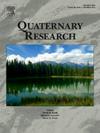全新世中晚期青藏高原南部人-动物-环境动态与畜牧业形成
IF 1.8
3区 地球科学
Q3 GEOGRAPHY, PHYSICAL
引用次数: 0
摘要
摘要本文采用标准的动物考古方法和新的骨物学方法,对青藏高原南部五个全新世中晚期遗址的动物遗骸进行了分析。根据分类生物考古遗迹的直接放射性碳年代,并与已发表的古气候数据进行比较,我们的发现揭示了STP约5.5至1.0 ka的农牧业发展的三阶段过程。在第一阶段,居住被限制在高原东南部,人类的生存主要基于觅食和低水平的猪-小米养殖。随着约3.8 ka的寒冷和干燥气候条件的出现,研究地区的中西部海拔较高的地区出现了越来越多的人类,同时也转向了牛饲养和大麦种植,即起源于西亚的农业实践;这些可能是在TP东部边缘之后引入STP和/或通过亚喜马拉雅山脉转移到达的。气候和生态退化可能导致当地狩猎活动减少,转而青睐耐寒、耐旱的畜牧业和作物。我们的研究表明,全新世中晚期的气候变化、生态变化、人类生存的转变和史前文化的传播是密切相关的。本文章由计算机程序翻译,如有差异,请以英文原文为准。
Human–animal–environment dynamics and formation of pastoralism in the southern Tibetan Plateau during the Middle–Late Holocene
Abstract In this paper, we apply standard zooarchaeological methods and novel osteological approaches to analyse faunal remains from five Middle–Late Holocene sites in the southern Tibetan Plateau (STP). Framed by direct radiocarbon dates on taxonomically classified bioarchaeological remains and compared with published palaeoclimate data, our findings revealed a three-stage process of agro-pastoral development in the STP ca. 5.5 to 1.0 ka. In the first phase, habitation was restricted to the lower southeastern part of the plateau and human subsistence essentially based on foraging and low-level pig–millet farming. With the onset of colder and drier climatic conditions ca. 3.8 ka, the study area witnessed a growing human presence at higher elevations in its central and western parts, together with a shift towards bovid husbandry and barley cultivation, that is, agricultural practices that originated in west Asia; these were likely introduced to the STP following the eastern margin of the TP and/or arrived by sub-Himalayan transfer. Climate and ecological degradation might have contributed to the decline of local game in favour of cold-and-dry-tolerant pastoral livestock and crops. Our work shows that Middle–Late Holocene climate change, ecological change, human subsistence shifts, and prehistoric cultural transmissions are intimately connected.
求助全文
通过发布文献求助,成功后即可免费获取论文全文。
去求助
来源期刊

Quaternary Research
地学-地球科学综合
CiteScore
4.70
自引率
8.70%
发文量
57
审稿时长
3 months
期刊介绍:
Quaternary Research is an international journal devoted to the advancement of the interdisciplinary understanding of the Quaternary Period. We aim to publish articles of broad interest with relevance to more than one discipline, and that constitute a significant new contribution to Quaternary science. The journal’s scope is global, building on its nearly 50-year history in advancing the understanding of earth and human history through interdisciplinary study of the last 2.6 million years.
 求助内容:
求助内容: 应助结果提醒方式:
应助结果提醒方式:


